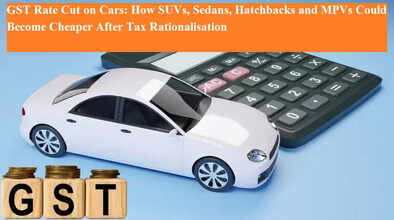GST Rate Cut on Cars: How SUVs, Sedans, Hatchbacks and MPVs Could Become Cheaper After Tax Rationalisation

The Indian automobile industry is set to witness a major shift in pricing as the government moves forward with its Goods and Services Tax (GST) rationalisation plan. With the Group of Ministers (GoM) approving a simplified tax structure, the new GST regime could significantly reduce the tax burden on passenger vehicles—ranging from compact hatchbacks to premium SUVs.
Currently, all cars attract a 28% GST, with an additional compensation cess of up to 22% depending on body style, length, engine capacity, and fuel type. This pushes the effective tax rate anywhere between 29% and 50%, making cars in India among the most heavily taxed in the world. By contrast, electric vehicles (EVs) attract only 5% GST with no cess, giving them a competitive edge.
What Changes Under the New GST Structure?
The present GST system operates across four slabs: 5%, 12%, 18%, and 28%. Under rationalisation, the 12% and 28% slabs will be eliminated, leaving only two primary rates—5% and 18%. In addition, a new 40% slab will be introduced specifically for luxury and so-called “sin goods.”
This proposal will be taken up for final discussion at the 56th GST Council meeting scheduled for September 3–4, 2025. If approved, it will mark one of the most significant tax reforms since GST was rolled out in 2017.
Current GST on Different Car Segments
To understand the shift, here’s a look at the existing GST and cess structure on cars:
-
Small cars (Petrol up to 1200cc / Diesel up to 1500cc, under 4m length): 28% GST + 1–3% cess = 29–31% total tax
-
Mid-size cars (Engines up to 1500cc): 28% GST + 17% cess = 45% total tax
-
Large cars (Engines above 1500cc): 28% GST + 20% cess = 48% total tax
-
SUVs (over 4m length, 1500cc+ engine, ground clearance above 170mm): 28% GST + 22% cess = 50% total tax
-
Hybrid cars (small, below 4m): 28% GST only = 28%
-
Hybrid cars (larger, above 4m): 28% GST + 15% cess = 43%
-
EVs (all segments): 5% GST = 5%
Which Cars Could Become Cheaper?
The biggest beneficiaries of the tax overhaul are likely to be small cars—including hatchbacks, compact sedans, MPVs, and entry-level SUVs. These models may shift from the 28% slab to the 18% slab, potentially lowering their on-road prices by 6–10%, provided the cess is removed or reduced.
For buyers, this could translate into savings of several thousand rupees on popular budget-friendly models. The move is expected to particularly benefit middle-class families, first-time buyers, and urban commuters looking for affordable vehicles.
However, the picture remains less clear for larger SUVs and premium cars. While they may fall under the new 40% GST slab, it is uncertain whether the compensation cess will continue. If the cess is retained, the net tax burden may remain high. On the other hand, if GST is capped at 40% with no cess, even bigger vehicles could see a price correction.
Industry Impact and Revenue Concerns
While the auto industry is optimistic about this move, some state governments have raised concerns over possible revenue losses. Cars contribute significantly to GST collections due to their high tax rates. To address this, the GST Council may consider an additional levy or alternative mechanisms to safeguard state revenues.
Experts suggest that if implemented thoughtfully, the reform could provide a much-needed boost to the automobile market, encouraging higher sales volumes, creating jobs, and reviving demand in a sector that has faced sluggish growth in recent years.
Conclusion
If approved, the GST rationalisation could mark a turning point for the Indian car market. For everyday consumers, small cars may finally become more affordable, while the fate of luxury and premium vehicles will depend on whether the cess is retained. As the industry awaits clarity from the upcoming GST Council meeting, one thing is certain: the Indian car buyer has plenty to look forward to in the months ahead.

